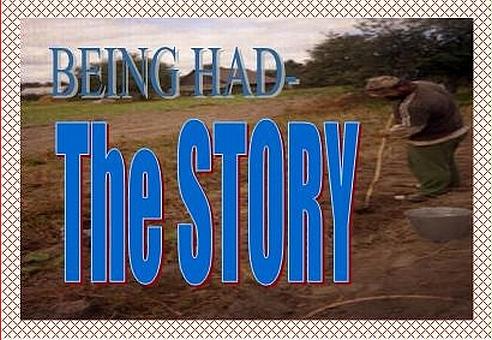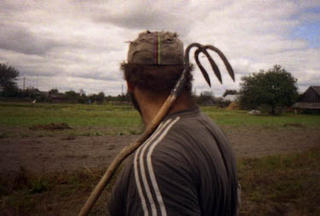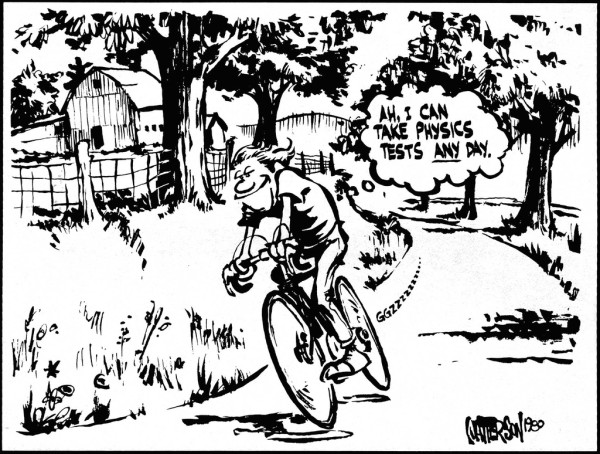I am sorry for being a day late. I have simply had too much work to do. I mentioned that I had gone copating kartoshka up at the farm. That means digging potatoes. Digging and digging and digging. It is a hell of a lot of work and it is really so hard on the body. If you check out the photo on my blogger profile, I have on my shoulder the digging instrument (copachic)that is used. Potatoes are grown best in hills, that is to say that trenches are dug around the plants so that the ground is soft around where the tubers will grow. And this along with having proper navoss, fertilizer, allows for the bulbs to grow large, which is what you want. Belarussian take particular pride in potato growing and it is a sign of one’s fitness for life that their potatoes come in, that they are huge, tasty and that there should be enough.
We didn’t plant this year like our neighbors did because we simply do not need as much. We have after all no pigs to feed. Or chickens or goats. We have only the four of us and so we only wanted, say, a half a ton for our food lockers rather than the two to three tons which is normal for the village. And also we had no real desire to grow potatoes for sale. The reason for this is that there is simply no money in it and it is far, far too much work. Last year potatoes sold to the truck drivers who come to the villages specifically to buy produce, went for 90 rubles a kilo. This is the same number that I mentioned the other day as what our apples went for several weeks ago: 1.7 cents a pound. Or in other words, about 34 dollars a ton. By the time I get to the end of this, I hope you will understand why we didn’t involve ourselves in this regardless of our precarious (read tragic) financial situation.
Yes, growing potatoes is hard work. I stopped writing this a few minutes ago to go and eat supper. We talked about Potato growing as we were eating. Basically, all living things need what they need in order to grow. Pardon the understatement. But potatoes need particular care in order to come in. The locals are really good at it because they have done this all of their lives. But we are learning and we try. And we did ok this year. Much, much better than last year.
But without going into too great detail, this is what is needed to grow potatoes. Firstly, the land needs to be plowed from the end of the previous year, and then raked smooth so the snow lays evenly and the water from the snow gets distributed evenly as well. This rakin the ground smooth is done twice after the end of the year plowing. This process takes a while as you can see.
In the spring, before the fertilizer is spread over the field, the field is usually plowed and raked twice again. Then the fertilizer which is a cow, horse and pig shit mixed with hay, and it is brought out onto the field by horsecart and spread with a rake and pitch fork. The cost these days is about 10,000 rubles, about $4.50 for a wagon-load (About a ton) of shit. It takes about four tons of shit to cover a field of our size. After spreading the fertilizer around (This process takes a while as you can see.), the field I now ready to be plowed for the last time. And, if you are growing potatoes, this is also the time to prepare to do your planting.
So, what you need to do now is to get everybody who will be eating these potatoes together. You drag out to the field your seed potatoes, the sacks weighing abut eighty to 100 pounds each and set them about 20 to 25 meters apart and off to the side from where you plan on planting your potatoes. You also need several rakes and hand baskets as well. And now you are ready to work. Somebody must do the plowing, which is in itself a pretty difficult task. And you have to know how to do this or your field with not be even or have the necessary canals that help keep the water from flooding the field if there is too much rain, like we had this year.
Anyway, basically what happens is the guy who is plowing makes a pass from one side of the field to the other. Then, he turns around and comes back again in the other direction, perhaps one quarter or one third the distance across the field. When he makes his passes, you and your people need to follow behind him with rakes and shove the shit that had previously been spread on the field into the furrow that has just been dug. The fertilizer needs to be below the plants you see so that the roots can grow down into it and feed the plants all through the course of its growing cycle. Once this is done, the rakes are put down and the baskets are filled with seed potatoes. You then walk back down the furrow sticking the potatoes in the ground into the side of the furrow and above the shit. When this is done, the horse can come around again and this time, the blade of the plow closes the furrow, planting the seeds and covering the shit. He then goes around the field once more, this time without any planting being done. You only plant in every other row. And of course the next time he comes around, you are raking and planting again. This process takes a while as you can see. Anyway, this is planting.
Within about three weeks, maybe a month, when the weather warms a bit, you begin to see your plants begin to sprout. Baby potato plants, like all young things are beautiful and appealing to look at. However, if you are getting potatoes, you are also getting lots of other plants that you don’t want or need or find attractive, and these weeds (travar) need to be removed. The way to do this is with an instrument similar to a hoe but thinner and wider and is known here as a sapka. This instrument both undercuts the weeds and also keeps the ground soft and fluffy, which the potatoes really like. And so, this is the first time that you are obligated to travel the length of your field, sapka in hand, fluffing and cutting away the young weeds and trying with all your might not to chop the young potato shoots. This process takes a while as you can see. And, it needs to be repeated about every two weeks.
Well, this is not really true because between two weeks and a month from when your potatoes start to grow, the field needs to be plowed again, this time with a special two sided plow that makes the hills that I mentioned earlier. After the potatoes are in hills, those weeds will still continue to come back so you need to keep going through the field with your sapka every two weeks or so. And plow again to keep the hills fresh. This process takes a while as you can see.
Oh, and I forgot to mention that this is about the time when the first of two varieties of bugs which are known here as coloradsky zhukes appear. The first variety looks a bit like ladybugs, but they have yellow and black stripes instead of being red with black spots. And unlike ladybugs who are really good at eating bugs you don’t like, these sons of bitches like to eat your potato plants down to the sticks if they can. The answer of curse is to spray which is of course a process that takes a while as you can see. The second variety by the way are impossibly ugly little red buggers that have little round, red, soft as jelly bodies that are simply too disgusting to think about. Anyway, spraying is another once every two week deal.
So anyway, you have done all this, you have beaten back the weeds, you have beaten back the bugs, you have avoided frost or too much water on the field, And now September has rolled around and you find that it is time to harvest your potatoes. So you take out your above mentioned instruments and you head put to undercut the hills and flush out your potatoes. Tatyana started on our field at about 7:30 Saturday morning and did not finish before dark. We could have been faster but my back cannot take holding the position required for effective digging, which is sort of like how a running back takes his stance behind the quarterback with knees bent and three fingers on the ground. But in this case, instead of four downs, you have about 3000 downs, one for every plant. And as you dig, copat, and flush out a group of potatoes (please, try not to cut the potatoes with your copachic) you pick them up and toss them over to the potatoes baskets and sort them for size: Eating potatoes (large), seeds (Medium) and svenya (Potatoes that go towards feeding the pigs, small). Hen the baskets are full, you take them over to the bags and after shaking out the extra dirt, you toss them in. This process takes a while as you can see.
After this is all done, the field must be plowed again and the process of digging through the field for potatoes is repeated again so that you can get to what potatoes you missed during the first time through. Then, and you have to know what it feels like to have to do this, the bags of potatoes are dumped ut under the sun so that the potatoes can dry out and make for themselves the hard skin which will protect them all through the winter months. Tey are then transported back into bags and moved to the food lockers (Podvals) and put to rest, waiting until such time as you might want to come and gather a bucket or so for some mashed, fried, baked, boiled, french fried, julienned, hash browned, stuffed or au gratine’d potatoes. This process takes a while as you can see.
So, as mentioned earlier, as I have done this now for the second time, I am hard pressed to imagine why, or how I would ever sell something for which I had to work that hard, for that long and endure so much pain for such unconscionable…unrealistic…immoral..evil... amounts of money. I mean, there is not enough heroin in the world to make be high enough to where I would believe that I should sell that much work for $17. Can you understand this? I grew my half ton this year. I made my quota. But such a number… and this is not even considering that I paid about that for the shit and the bug spray anyway…
Do you understand what I am sayng? I would pull Beelzebub himself from his car and punch him out, perfectly well knowing that I would be held in Polish hell without my passport for all eternity before I would sell my whole field of potatoes for s-e-v-e-n-t-e-e-n f-u-c-k-i-n-g d-o-l-l-a-r-s!
But we do here. We do. You know, at the markets, they sell potatoes for about 150-250 rubles a kilo, about $70 to $115 a ton, but of course they have to add both standing out at the market selling and being willing to deliver the bags to the folks who buy from you. Or of course before this year, you could have packed up your potatoes and traveled to Moscow to sell them at market. I hear that you can get as much as a quarter a kilo there. But then this year our president put a tax on doing that, so it is a little harder…
Anyway, that is my story for today. It was about potatoes. This process takes a while as you can see.
If you have any questions or comments about this post, the blog in general, Poland or Belarus, please contact me at:
beinghad_mail@yahoo.com
For a complete listing of all of the pages of the Being Had Blog, please click HERE to navigate to the HOMEPAGE.
And thank you for reading me.
More soon…























0 Comments:
Post a Comment
Subscribe to Post Comments [Atom]
<< Home